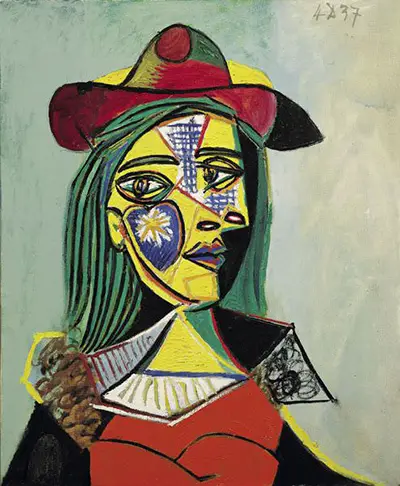As one of the most popular artists alive who is still studied all over the world today, there is little wonder we still take such an interest in his works.
Woman in a Hat and Fur Collar is one of the many works that Picasso did on his lover at the time - Mary Therese Walter. It was painted in the capital city of romance, Paris, and Picasso used his unique style to portray the women who became the mother of his Daughter.
Between 1927 and 1935, Picasso painted many pictures of Walter, in his familiar style. Picasso's love life has always been a point of interest for art historians, and because Walter was his mistress initially, many are surprised that he so brazenly painted her for all the world to see, especially as he was married to Olga Khokhlova at the time he started the affair.
During this crossover period, Picasso would continue to paint exhaustive works of his lover, and it is still widely debated as to whether this was with his Wife's knowledge or consent or not.
Picasso's painting 'Woman in Hat and Fur Collar' follows his signature style of cubism and surrealism. One of the main draws of the painting is that it appears to portray not only the front of the face but also the side profile - a style in which Picasso became incredibly famous for. The youth and personality of Walter was something that Picasso analysed exhaustively, and his pictures of her took many transformations, most of which were at a metamorphic level.
Most art critic agree that Picasso's style of merging together the face and the side profile in his style of incredibly vivid imagery paint the picture of a sensual woman who was suffering from internal conflict, potentially that of being involved with a married man. Many people argue that the image is a juxtaposition of two people, namely Walter and Dora Maar. Compared to Picasso's other paintings of Dora Maar however, this one is easily distinguishable as Walter. The style manages to portray emotion in an intensity that is not usually seen in traditional style paintings.
Pablo Picasso is on of the most well names in art. He was born in Spain in 1881 and on his Mothers side was 1/4 Italian. From an early age, he showed passion and interest in drawing. It is a widely known fact that his first word was the Spanish word for 'pencil'. Not wanting to waste his talent, he trained under his Father until at 16 he was sent to one of the most prestigious art schools in their local area.
It wasn't until 1893 that the inexperienced Picasso really started to come into his own, and this is when he started to craft the style that would follow him for the rest of his life. His widely reported blue period, between 1901 and 1904 saw him lend himself to a style that was characterised by sombre blue paintings. The suicide of his friend and a trip through Spain, possibly seeing the poverty that befell families not as well off as his, contributed to this melancholy style.
His rose period between 1904 and 1906 saw him start to use warmer colours and paint pictures that had the style of someone who was in a better place internally than the previous period. In 1909, he started to form his ideas on cubism, first in an analytic style and then in a synthetic style. Once he had moved on to the style of synthetic cubism, he followed this movement for the rest of his life and became widely known as someone who was the co-founder of this movement.
Picasso made such an impression on the art world, he is still studied as an artist today with students studying cubism in great depth. The likelihood is that even people that do not have an interest in art or circulate in art circles would have had some prior knowledge of him or at least seen one of his works.

